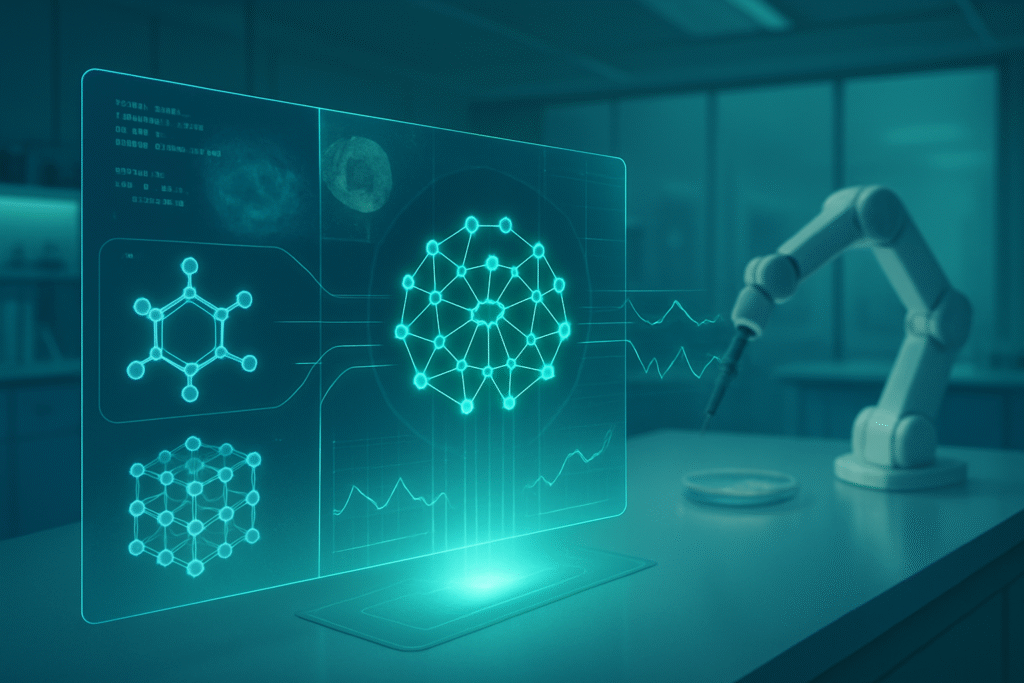
Multimodal Language Models (MMLMs) are rapidly ushering in a new era for chemistry and materials science, fundamentally transforming how scientific discovery is conducted. These sophisticated AI systems, capable of seamlessly integrating and processing diverse data types—from text and images to numerical data and complex chemical structures—are accelerating breakthroughs and automating tasks that were once labor-intensive and time-consuming. Their immediate significance lies in their ability to streamline the entire scientific discovery pipeline, from hypothesis generation to material design and property prediction, promising a future of unprecedented efficiency and innovation in the lab.
The advent of MMLMs marks a pivotal moment, enabling researchers to overcome traditional data silos and derive holistic insights from disparate information sources. By synthesizing knowledge from scientific literature, microscopy images, spectroscopic charts, experimental logs, and chemical representations, these models are not merely assisting but actively driving the discovery process. This integrated approach is paving the way for faster development of novel materials, more efficient drug discovery, and a deeper understanding of complex chemical systems, setting the stage for a revolution in how we approach scientific research and development.
The Technical Crucible: Unpacking AI's New Frontier in Scientific Discovery
At the heart of this revolution are the technical advancements that empower MMLMs to operate across multiple data modalities. Unlike previous AI models that often specialized in a single data type (e.g., text-based LLMs or image recognition models), MMLMs are engineered to process and interrelate information from text, visual data (like reaction diagrams and microscopy images), structured numerical data from experiments, and intricate chemical representations such as SMILES strings or 3D atomic coordinates. This comprehensive data integration is a game-changer, allowing for a more complete and nuanced understanding of chemical and material systems.
Specific technical capabilities include automated knowledge extraction from vast scientific literature, enabling MMLMs to synthesize comprehensive experimental data and recognize subtle trends in graphical representations. They can even interpret hand-drawn chemical structures, significantly automating the laborious process of literature review and data consolidation. Breakthroughs extend to molecular and material property prediction and design, with MMLMs often outperforming conventional machine learning methods, especially in scenarios with limited data. For instance, models developed by IBM Research have demonstrated the ability to predict properties of complex systems like battery electrolytes and design CO2 capture materials. Furthermore, the emergence of agentic AI frameworks, such as ChemCrow and LLMatDesign, signifies a major advancement. These systems combine MMLMs with chemistry-specific tools to autonomously perform complex tasks, from generating molecules to simulating material properties, thereby reducing the need for extensive laboratory experiments. This contrasts sharply with earlier approaches that required manual data curation and separate models for each data type, making the discovery process fragmented and less efficient. Initial reactions from the AI research community and industry experts highlight excitement over the potential for these models to accelerate research, democratize access to advanced computational tools, and enable discoveries previously thought impossible.
Corporate Chemistry: Reshaping the AI and Materials Science Landscape
The rise of multimodal language models in chemistry and materials science is poised to significantly impact a diverse array of companies, from established tech giants to specialized AI startups and chemical industry players. IBM (NYSE: IBM), with its foundational models demonstrated in areas like battery electrolyte prediction, stands to benefit immensely, leveraging its deep research capabilities to offer cutting-edge solutions to the materials and chemical industries. Other major tech companies like Google (NASDAQ: GOOGL) and Microsoft (NASDAQ: MSFT), already heavily invested in large language models and AI infrastructure, are well-positioned to integrate these multimodal capabilities into their cloud services and research platforms, providing tools and APIs for scientific discovery.
Specialized AI startups focusing on drug discovery, materials design, and scientific automation are also experiencing a surge in opportunity. Companies developing agentic AI frameworks, like those behind ChemCrow and LLMatDesign, are at the forefront of creating autonomous scientific research systems. These startups can carve out significant market niches by offering highly specialized, AI-driven solutions that accelerate R&D for pharmaceutical, chemical, and advanced materials companies. The competitive landscape for major AI labs is intensifying, as the ability to develop and deploy robust MMLMs for scientific applications becomes a key differentiator. Companies that can effectively integrate diverse scientific data and provide accurate predictive and generative capabilities will gain a strategic advantage. This development could disrupt existing product lines that rely on traditional, single-modality AI or purely experimental approaches, pushing them towards more integrated, AI-driven methodologies. Market positioning will increasingly depend on the ability to offer comprehensive, end-to-end AI solutions for scientific research, from data integration and analysis to hypothesis generation and experimental design.
The Broader Canvas: MMLMs in the Grand AI Tapestry
The integration of multimodal language models into chemistry and materials science is not an isolated event but a significant thread woven into the broader tapestry of AI's evolution. It underscores a growing trend towards more generalized and capable AI systems that can tackle complex, real-world problems by understanding and processing information in a human-like, multifaceted manner. This development aligns with the broader AI landscape's shift from narrow, task-specific AI to more versatile, intelligent agents. The ability of MMLMs to synthesize information from diverse modalities—text, images, and structured data—represents a leap towards achieving artificial general intelligence (AGI), showcasing AI's increasing capacity for reasoning and problem-solving across different domains.
The impacts are far-reaching. Beyond accelerating scientific discovery, these models could democratize access to advanced research tools, allowing smaller labs and even individual researchers to leverage sophisticated AI for complex tasks. However, potential concerns include the need for robust validation mechanisms to ensure the accuracy and reliability of AI-generated hypotheses and designs, as well as ethical considerations regarding intellectual property and the potential for AI to introduce biases present in the training data. This milestone can be compared to previous AI breakthroughs like AlphaFold's success in protein folding, which revolutionized structural biology. MMLMs in chemistry and materials science promise a similar paradigm shift, moving beyond prediction to active design and autonomous experimentation. They represent a significant step towards the vision of "self-driving laboratories" and "AI digital researchers," transforming scientific inquiry from a manual, iterative process to an agile, AI-guided exploration.
The Horizon of Discovery: Future Trajectories of Multimodal AI
Looking ahead, the trajectory for multimodal language models in chemistry and materials science is brimming with potential. In the near term, we can expect to see further refinement of MMLMs, leading to more accurate predictions, more nuanced understanding of complex chemical reactions, and enhanced capabilities in generating novel molecules and materials with desired properties. The development of more sophisticated agentic AI frameworks will continue, allowing these models to autonomously design, execute, and analyze experiments in a closed-loop fashion, significantly accelerating the discovery cycle. This could manifest in "AI-driven materials foundries" where new compounds are conceived, synthesized, and tested with minimal human intervention.
Long-term developments include the creation of MMLMs that can learn from sparse, real-world experimental data more effectively, bridging the gap between theoretical predictions and practical lab results. We might also see these models developing a deeper, causal understanding of chemical phenomena, moving beyond correlation to true scientific insight. Potential applications on the horizon are vast, ranging from the rapid discovery of new drugs and sustainable energy materials to the development of advanced catalysts and smart polymers. These models could also play a crucial role in optimizing manufacturing processes and ensuring quality control through real-time data analysis. Challenges that need to be addressed include improving the interpretability of MMLM decisions, ensuring data privacy and security, and developing standardized benchmarks for evaluating their performance across diverse scientific tasks. Experts predict a future where AI becomes an indispensable partner in every stage of scientific research, enabling discoveries that are currently beyond our reach and fundamentally reshaping the scientific method itself.
The Dawn of a New Scientific Era: A Comprehensive Wrap-up
The emergence of multimodal language models in chemistry and materials science represents a profound leap forward in artificial intelligence, marking a new era of accelerated scientific discovery. The key takeaways from this development are manifold: the unprecedented ability of MMLMs to integrate and process diverse data types, their capacity to automate complex tasks from hypothesis generation to material design, and their potential to significantly reduce the time and resources required for scientific breakthroughs. This advancement is not merely an incremental improvement but a fundamental shift in how we approach research, moving towards more integrated, efficient, and intelligent methodologies.
The significance of this development in AI history cannot be overstated. It underscores AI's growing capability to move beyond data analysis to active participation in complex problem-solving and creation, particularly in domains traditionally reliant on human intuition and extensive experimentation. This positions MMLMs as a critical enabler for the "self-driving laboratory" and "AI digital researcher" paradigms, fundamentally reshaping the scientific method. As we look towards the long-term impact, these models promise to unlock entirely new avenues of research, leading to innovations in medicine, energy, and countless other fields that will benefit society at large. In the coming weeks and months, we should watch for continued advancements in MMLM capabilities, the emergence of more specialized AI agents for scientific tasks, and the increasing adoption of these technologies by research institutions and industries. The convergence of AI and scientific discovery is set to redefine the boundaries of what is possible, ushering in a golden age of innovation.
This content is intended for informational purposes only and represents analysis of current AI developments.
TokenRing AI delivers enterprise-grade solutions for multi-agent AI workflow orchestration, AI-powered development tools, and seamless remote collaboration platforms.
For more information, visit https://www.tokenring.ai/.





